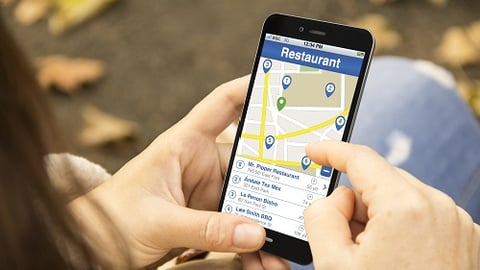Mar 06, 2025
Local SEO for Restaurants: Your Recipe for Online Visibility

In today’s digital-first world, people don’t just walk around looking for a place to eat—they Google it. Whether it's a quick lunch spot, a family dinner destination, or a cozy café to work from, the majority of dining decisions now begin with a search.
That’s where Local SEO for restaurants becomes a game-changer.
If your restaurant isn’t appearing in location-based search results when hungry customers nearby are searching for food, you’re missing out on high-intent traffic. Local SEO ensures your restaurant is discoverable when it matters most—right when someone is searching for the exact experience you offer.
Let’s explore why local SEO is essential for restaurants and how to implement it effectively.
What is Local SEO for Restaurants?
Local SEO is the practice of optimizing your restaurant’s online presence to rank higher in local search results. It helps your business appear in searches like:
- "Pizza near me"
- "Cafes open now in [location]"
- "Best vegetarian restaurant in [area]"
This form of SEO focuses on geographical relevance and user intent, making it ideal for brick-and-mortar businesses like restaurants. Whether you run a multi-location chain or a single-location café, local SEO for cafes and restaurants can help you reach customers actively searching in your neighborhood.
Why Local SEO is a Must-Have for Restaurants
The competition in the food and hospitality industry is intense. A well-reviewed, well-optimized restaurant that appears in the top local results will often get the first click—and the customer.
Here’s why local SEO is essential:
- Increased visibility on Google Maps and local search results
- More foot traffic from nearby users
- Improved online reputation and trust
- Higher chances of appearing in the coveted Google 3-Pack
- Better performance on food delivery platforms and directories
Local SEO isn’t just about rankings—it’s about putting your restaurant where your customers are looking.
1. Optimize Your Google Business Profile (GBP)
Your Google Business Profile is the foundation of local SEO. It often serves as a potential customer’s first impression of your restaurant. An incomplete or outdated profile can mean lost opportunities.
To fully optimize your GBP:
- Use your official business name, avoiding extra keywords.
- Choose the most relevant categories (e.g., Restaurant, Café, Italian Restaurant).
- Add high-resolution images of your dishes, seating areas, and ambiance.
- Include accurate business hours, contact info, and your website link.
- Regularly update posts for events, promotions, or special menus.
An optimized and active Google Business Profile signals trust and relevance to both Google and your customers.
2. Use Location-Based Keywords Throughout Your Website
To rank in local searches, your website content must reflect the terms people are using to find businesses like yours. Incorporate keywords like:
- “Local SEO for restaurants”
- “Local SEO for cafes and restaurants”
- “[Cuisine] restaurant in [city or neighborhood]”
- “Best lunch spots in [area]”
These keywords should be naturally included in:
- Page titles and meta descriptions
- Homepage and about page content
- Menu and service pages
- Blog posts and FAQs
Keyword integration should feel organic, not forced. It’s important to maintain a balance between readability and optimization.
3. Create Dedicated Location Pages
If your restaurant has multiple outlets or serves multiple neighborhoods, it’s important to create individual landing pages for each location.
These pages should include:
- The address and contact details of that location
- Specific services or menu variations
- Customer testimonials or reviews from that location
- Nearby landmarks or points of interest
This signals to search engines that you’re locally relevant in more than one area, helping you rank better across multiple regions.
4. Earn and Manage Online Reviews
Customer reviews not only influence new customers but also play a critical role in your local SEO ranking. Google and other search engines factor reviews into how they rank local businesses.
Encourage satisfied customers to leave reviews on platforms like:
- Tripadvisor
- Zomato
- Yelp
Make it easy for customers to review by adding direct links on your website, email signatures, and digital receipts. Most importantly, respond to reviews—both positive and negative—with professionalism and gratitude. Engagement shows you care and helps boost your credibility.
5. Ensure Consistency Across All Online Listings
Your restaurant may be listed on various online platforms—delivery apps, food directories, review sites, and business directories. It's essential that your business name, address, and phone number (NAP) are consistent across all of them.
Even minor inconsistencies can confuse search engines and hurt your local SEO performance.
Use tools like Moz Local or BrightLocal to audit your listings and fix any discrepancies. The more consistent your online presence, the more search engines will trust and rank your restaurant.
6. Build High-Quality Local Backlinks
Links from other local websites and blogs help boost your site’s domain authority and search visibility.
Effective backlink strategies for restaurants include:
- Collaborating with local food bloggers or influencers
- Participating in community events or festivals and getting listed on their websites
- Sponsoring local school or college events
- Listing your business in local press or city-specific guides
These backlinks not only help with SEO but also bring in referral traffic from relevant, nearby audiences.
7. Create Locally-Relevant, Useful Content
Blogging may not be the first thing that comes to mind when marketing a restaurant, but it can give you an edge. Creating localized content that resonates with your community helps build trust and improve rankings.
Ideas include:
- “5 Signature Dishes You Must Try at Our [City] Outlet”
- “Top Places to Eat in [Area] – Our Favorite Neighbors”
- “How We Source Local Ingredients in [City]”
Content like this shows your involvement in the community and can rank for additional local keywords.
8. Optimize for Mobile and Voice Search
A large portion of local food-related searches happen on mobile devices, often via voice assistants. Your site must be mobile-friendly, with fast load times, easy navigation, and clear calls to action.
Also consider optimizing for voice search by including conversational keywords and question-based content. A frequently asked questions (FAQ) section addressing common queries like “Do you offer takeaway?” or “Is there parking available?” can help capture voice traffic.
9. Add Structured Data (Schema Markup)
Technical SEO elements like schema markup help search engines understand your content more effectively. Adding Restaurant Schema can improve your chances of showing enhanced listings in search results.
This markup can include information such as:
- Restaurant name and address
- Opening hours
- Menu items
- Reviews and ratings
While this may require a developer’s help, it’s a powerful tool for improving visibility and click-through rates.
10. Track Performance and Adjust
Like any strategy, local SEO should be continuously monitored and refined. Use tools such as:
- Google Analytics for tracking website traffic and behavior
- Google Search Console for keyword performance and indexing
- Google Business Profile Insights for visibility and engagement metrics
Regular audits and data reviews will help you understand what’s working and where improvements are needed.
Conclusion: Make Your Restaurant Discoverable Where It Matters Most
Local SEO for restaurants isn’t just about rankings—it’s about being found by people who are ready to dine, order, or visit. Whether you run a fine dining establishment or a quaint neighborhood café, local SEO ensures your business is seen by those who are actively searching for the experience you provide.
From optimizing your Google Business Profile to building local authority through reviews and backlinks, every step of local SEO is an investment in long-term visibility and growth.
At Uprankx, we specialize in tailored local SEO strategies for businesses in the food industry. If you're ready to get more traffic, more customers, and more revenue from local search, our team is here to help you grow.




